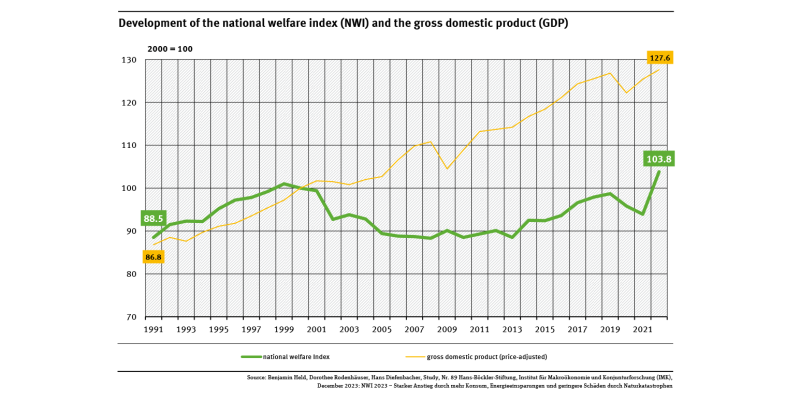Indicator: National Welfare Index
 Click to enlarge
Click to enlargeSource: Held et al./Institut für Makroökonomie und Konjunturforschung/Statistisches Bundesamt Figure as PDF
 Umweltbundesamt
Umweltbundesamt
 Click to enlarge
Click to enlarge
- A graph shows the national welfare index (NWI) and gross domestic product (2000 = 100) for the years between 1991 and 2022. Since 2000, the NWI fell by 3.6 percent, while GDP rose by 27.6 percent.
- The national welfare index (NWI) includes overall 21 activities that raise and diminish welfare.
- The NWI shows a different course than GDP. It fluctuates in phases, but there is no discernible long-term trend.
GDP indicates the economic performance of an economy and has been recognised as an internationally comparable statistical parameter. However, GDP is not a suitable measure of social welfare. The main criticisms include the fact that GDP does not take into account distribution of income and does not incorporate voluntary work and housework. Furthermore, it does not include costs through damage to the environment. Thus it does not show decreases in natural capital. So-called defensive expenses to combat crime, drug use or the subsequent costs of traffic accidents or natural disasters even tend to have a positive effect on the GDP.
The NWI has been developed as an indicator that takes account of such criticism. Based on consumption expenditure, it contains bonus and malus components, depending on whether they contribute to welfare or not. Greater income inequality lowers the value of the index. Environmental costs and consumption of non-renewable resources are examples of negative categories, voluntary work and housework for positive categories. The NWI has been increasingly used by the German Federal States.
The development of the NWI since 1991 shows different trends. Until 1999 a continuous increase parallel to GDP can be observed. This is followed by a disparity: While GDP continues to rise, the NWI falls. The main cause was the increasing income inequality. Between 2005 and 2013 there were hardly any fluctuations of the NWI. From 2014 on there was a positive trend. Consumer spending increased, inequality stagnated and environmental costs decreased slightly. In the pandemic year, however, both GDP and NWI fell abruptly. Whereas the GDP recovered in 2021, particularly the floods on the Ahr and Erft rivers caused the NWI to drop further. In 2022, there was a strong increase due to rising consumer spending (also due to the relief packages), energy savings and lower damage from natural disasters compared to the previous year. However, inflation and increased flight emissions dampened the increase considerably.
The increasing inequality of income distribution in the 2000s is the main reason for the fall in the NWI. Initial estimates for 2023 show a slight decline in environmental pollution, caused in particular by falling energy consumption and the associated lower emissions. However, there is a tendency towards negative developments in consumption and possibly increasing income inequality. Further information can be found in a detailed current evaluation of the NWI (in German only).
The NWI is the sum of 21 monetarily assessed components, the most important of which is real consumption expenditure weighted by the distribution of income (Gini coefficient). There are more welfare-enhancing components such as housework, volunteer work and expenditure for health and education that have a positive impact on the NWI, whereas negative activities are subtracted, such as environmental damage or crime. A more detailed description of the calculation method is found at NWI 3.0 Methodenbericht Nationaler Wohlfahrtsindex 3.0 (in German only). On the Research Institute of the Protestant Study Community (FEST) website the latest publications can be found.